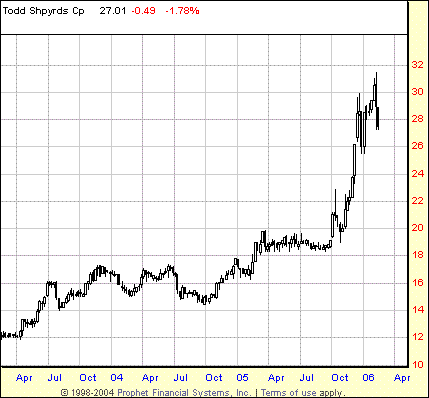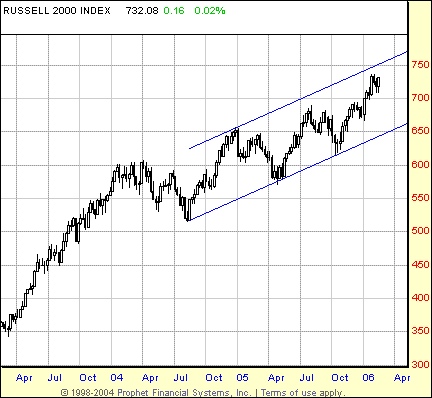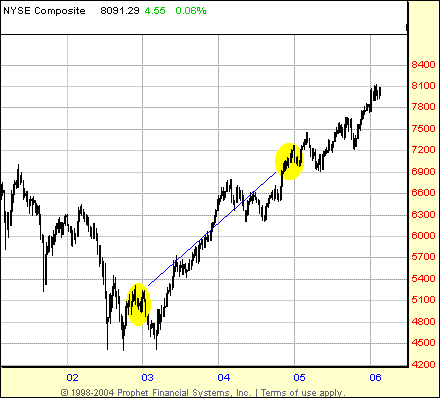
HOT TOPICS LIST
- Strategies
- Stocks
- Buy
- Investing
- Brokers
- Psychology
- Interviews
- Accumulate
- Sell
- Hold
- Spotlight
- Websites
- Candlestick Corner
- Gold & Metals
- Options Trading
LIST OF TOPICS
VIEWS FROM THE FIELD
Liquidity And Growth
03/02/06 12:14:18 PM PSTby David Penn
Cash on the sidelines and revenue growth are still the primary ingredients for any sustained market rally.
By now, regular Working-Money.com readers are likely familiar with Jordan Kimmel, portfolio manager for Magnet Investing Group and market strategist for National Securities Corp., with whom we spoke last summer and autumn as part of our Views From The Field series. With the start of the new year only recently behind us, new all-time highs in the Dow Jones Transportation Average, and uncertainties about the fortunes of oil and gold, it seemed like a good idea to check back with Kimmel to see how some of the economic and market factors he urged us to look forward to last year are looking right now. Obviously, analyzing the strength or weakness of the stock market is not child's play. But at the same time, Jordan Kimmel suggests that there are a few things that investors, speculators, and traders can focus on that will keep them on the right side of the market far more often than not. Those things? Liquidity and growth. New highs and new lows. Says Kimmel, "The internals of the market are the most important thing to watch if you want to see how the market is going." By internals, he is referring specifically to such indicators as the advance/decline line and the number of new highs compared to new lows. "There has been no bear market that has started in the past 100 years with an AD [advance/decline] line that is positive," Kimmel notes. On the other hand, "a negative line is the best indicator." In addition to advance/decline statistics, Kimmel pays attention to the number of stocks making new 52-week highs compared to the number of stocks making 52-week lows. Technicians tend to use either the new highs-new lows indicator (which, according to Steven Achelis of Technical Analysis From A To Z, can be treated as either a divergence indicator or an oscillator), or instead make a ratio of new highs divided by new lows. In either event, as far as Kimmel is concerned, this is an important study for investors, speculators, and traders to conduct. "[You] really need to look at the NH/NL on each up and down movement in the market," he says. "The last big move down in January saw new lows drop significantly compared to the last move down." New lows, he points out, will be few and far between at the "absolute highs," and new highs will be through the roof -- "the opposite extreme" -- at the final bottom. What we are experiencing in the first few months of 2006, says Kimmel, "are now a very healthy set of numbers indicating more fuel" for a move higher. THE SECTORS AND THE STREET So if that's the case, then what kind of stock market stock cars are being propelled by that fuel? Asked about the hype surrounding retail stocks with their breakout sales numbers from January, Kimmel was cautious. "[There] aren't that many retail companies that are coming to the top of our list," he reported. "It's kind of interesting ... the death of the consumer has been widely exaggerated [and] the tremendous cost of gasoline has been cited" but only a modest percentage of real consumer spending is affected, "except at the bottom of the economy, which doesn't drive the economy anyway." If the shine from retail stocks is more apparent than real, what market areas does Kimmel (and, more important, Kimmel's Magnet investing approach) like? Scanning the top 20 stocks based on Magnet criteria, I noted that technology, transportation, and energy stocks were the dominant outperforming sectors (Figure 1). To this, Kimmel pointed out that there are more than a few wise guys taking potshots at the basic materials/commodities thesis.
FIGURE 1: TODD SHIPYARDS CORPORATIONS, WEEKLY. A member of one of the outperforming market sectors, the transports, Todd Shipyards has been among the higher-ranked Magnet stocks |
"Contrarians are trying to say that basic materials are over with -- I don't agree with that analysis at all," says Kimmel. In fact, from a macro standpoint, he insists that the tremendous globalization that began (arguably) with the fall of the Berlin Wall and has continued with the opening of markets in Eastern Europe, India, and China is likely to continue, keeping a relatively steady demand for commodities and commodity production. Says Kimmel: "This is not a short-term trend. The businesses themselves, copper companies, steel ... they are continuing to show revenue growth and margin growth." To emphasize his point, he noted the merger between the no. 1 and no. 2 rolled steel manufacturers. "Corporations are looking at their own balance sheets and are finding themselves attractive," he concludes. This is happening, "even as investors and others are writing them off." So the basic materials/commodities thesis has to do with worldwide historical trends that are not likely to reverse any time soon. But can the same thing be said about technology stocks, which are also among the better-regarded Magnet stocks? Says Kimmel, "There continues to be this belief that tech is dead and will not come back." While that might be right insofar as the stocks that led the last bull market are not likely to lead the next one, he says, "We will continue to find those companies that are experiencing profit and revenue increases." As for transportation stocks, Kimmel is no less encouraged by their outperformance. "The transportation index just had an all-time high," he said. "[The transports] are a leading indicator, not a lagging one, and that bodes well for the future." Kimmel also sees bullish signs in the emergence of sectors like health care, gaming stocks, and even insurance. "These are all true growth areas," he points out. As such, they tend to encourage an increase in confidence in both individual investors, the media, and money managers when these stocks begin to show some life. Says Kimmel, "There are so many signs that the market and the economy are strong. That can be the case even when things slow down a little bit -- as long as there is liquidity and growth." YIELDING TO THE CURVE To say that money makes the world go 'round may be invoking one of the most tiresome cliches about cash, but being tiresome is no argument against being right. For all the cash on the sidelines, as Kimmel has repeatedly pointed out to investors and clients, he still expects talk of a slowdown in 2006 to begin percolating by midyear. The culprit? In part, Kimmel believes that the warning of an inverted yield curve needs to be acknowledged, if not accepted. "If you look at every inverted yield curve in the last several decades," he says, "almost invariably they lead to a recession." This is because, as he puts it, the opportunity for banks to "lend out cheap money" is gone. "Not only are the interest rates on the short term inverting the curve," adds Kimmel, "but also the Fed has really slowed down the creation of new money." He includes himself among those market watchers and Fed observers who harbor at least some creeping suspicion about the Federal Reserve Board's decision to stop releasing certain money creation statistics, particularly the end this spring of official reports on what is referred to as "M3," the broadest measure of the supply of money. Rumors and speculation run rampant on this issue, from those who believe the controversy over the Fed's decision is much ado about nothing, to those who fear that hiding M3 figures presages an excursion into wholesale monetary inflation. But until that mystery is resolved, Kimmel is content to focus on what he calls the "most important overriding factor" in the markets today: namely, money on the sidelines from both individual investors and corporations around the world. Touching on the "global savings glut" theory popular among many economists, Kimmel points out that "[there is] too much money on the sidelines that needs someplace to go." That money, he says, "remains at an all-time high relative to the total capitalization of the stock market." So what is all that money doing on the sidelines rather than getting into the game? Kimmel believes the culprits are "fear and disbelief" -- adding that "as soon as this market breaks to the upside, you will see even higher volume from the sidelines, from the bond market, from housing." What of the bear case? The Great Housing Bubble, consumer and government debt run amok, half the planet with nuclear weapons and the other half desperately seeking some. ... Kimmel acknowledges all of these threats to a rising stock market, but -- as with housing, the misfortunes of which might actually benefit the stock market -- he still believes that the bias remains to the upside as far as stocks go. With regard to the notion of there being "too much debt," Kimmel notes that the wealth and net worth of Americans just crossed the $50 trillion mark for the first time. "You need to always look at the ability to pay the debt," he says, allowing that if there is any place where debt could be a problem, then it would be in the housing market. But even there, Kimmel sees caveats. "The crazy mortgages [zero down, negative amortization] are coming to an end," Kimmel says. "Clearly, there was speculation that will come to a dramatic slowdown," but it "does not bode for a collapse." In fact, he believes that the "speculative fever" that drove house prices into the stratosphere "is likely to move back to stocks." Kimmel avers that that transfer already began back in 2005. "The biggest money is not chasing real estate [any more]." LOOKING FORWARD For someone who relies on a stock selection methodology -- Magnet investing -- that is so exacting, Kimmel has macro theories about economies and societies, markets and human beings that help guide his outlook on the opportunities for investors, speculators, and traders. Worldwide demographic changes -- including both the industrialization (and digitalization) of China and formerly Communist Russia and formerly "nonaligned" India -- are among the most pressing of these macro theories. "There is an increased population of consumers," Kimmel observes. "[And] this is a trend that is not a boom and bust cycle. It will probably last for decades." He is quick to point out that such demographic trends do not mean that "every stock is good or that there won't be [market] weakness. But," he says, "there is a trend in place that isn't anywhere near short term." In fact, Kimmel sees the combination of often news-driven events on the international scene and the potential for market weakness as the formula for opportunity. "I would expect there to be stories of significant problems developing in one area of the world that will put into question the whole idea of global growth," says Kimmel, underscoring the sort of "wall of worry" that always accompanies strong moves higher in the markets. "International markets are more volatile, prone to news-driven events. [Investors should] expect temporary shock waves to create volatility." But again, in that volatility, Kimmel sees opportunity. "The biggest corporations and all the cash on the sidelines will be there in those pockets of weakness," he says. But one of Kimmel's biggest macro theories is nothing so new as the opening of new global markets or historic demographic shifts. Call it "sentiment," call it "emotional memory," but the psychology and tendencies of the average investor play almost as big a role in Kimmel's understanding of market opportunity as any other factor. "[The] public is still very nervous about any declines," he comments. "There is still a disbelief by the individual that the market is healthy." He ticks off the items of unreality: the trading range of the Standard & Poor's 500, the NASDAQ still down from its peak. "People don't look at the S&P 600 [an index of small-capitalization stocks] or the Dow transports or the Russell 2000 [another index of small capitalization stocks] (Figure 2)," he says. "This is a much stronger market than people understand."
FIGURE 2: RUSSELL 2000 INDEX, WEEKLY. Jordan Kimmel considers the small-cap Russell 2000 index to be among those that investors and speculators should pay more attention to -- with less attention to the S&P 500 and DJIA. |
Kimmel points to a recent Money Show he attended as evidence that there remains a reservoir of reserve that is keeping many investors limited in their exposure to the stock market. "There wasn't anybody talking about very strong returns," he says. "They'd all be happy with high single-digit returns." This, of course, runs counter to the stocks uncovered on a daily basis through his Magnet selection process. "When you look at our newsletter and you see the returns on individual stocks that are the %91magnets' of the market," he says, "what surprised me [are] the still relatively low expectations (among investors)." Kimmel adds that individual stocks are showing much more powerful moves than the indexes, and even if "there are really only 50-60 companies" that are able to make their way through Kimmel's Magnet selection process, "that's plenty" for the average investor to study and choose from. As far as 2006 is concerned, Kimmel points out that the midyear election cycle might be among the "catalysts" for the kind of returns he is expecting going forward. "Historic returns from the midelection point to the highs of the election year [are] the most dramatic returns in any cycle," he notes. "[Even] if there is a midyear correction, there's too much money [on the sidelines] to let things get out of hand." (See Figure 3.)
FIGURE 3: NEW YORK STOCK EXCHANGE COMPOSITE, WEEKLY. According to Kimmel and a number of market historians, the period between the mid-term Congressional elections and the Presidential election is typically bullish. |
What's the bottom line? "Until I see deterioration in the AD [advance/decline] line," Kimmel says, "or in the feel and look of the markets, [I think] 2006 will surprise people to the upside." SUGGESTED READING Achelis, Steven B. [2000]. Technical Analysis From A To Z, McGraw-Hill. Kimmel, Jordan L. [2000]. Magnet Investing, Next Decade. Loeb, Gerald [1996]. The Battle For Investment Survival, John Wiley & Sons. Penn, David [2005]. "Jordan Kimmel Of Magnet Investing," Working-Money.com, August 5. _____. [2005]. "Magnets and Market Direction," Working-Money.com, November 23. Current and past articles from Working Money, The Investors' Magazine, can be found at Working-Money.com. |
Technical Writer for Technical Analysis of STOCKS & COMMODITIES magazine, Working-Money.com, and Traders.com Advantage.
| Title: | Traders.com Technical Writer |
| Company: | Technical Analysis, Inc. |
| Address: | 4757 California Avenue SW |
| Seattle, WA 98116 | |
| Phone # for sales: | 206 938 0570 |
| Fax: | 206 938 1307 |
| Website: | www.traders.com |
| E-mail address: | DPenn@traders.com |
Traders' Resource Links | |
| Charting the Stock Market: The Wyckoff Method -- Books | |
| Working-Money.com -- Online Trading Services | |
| Traders.com Advantage -- Online Trading Services | |
| Technical Analysis of Stocks & Commodities -- Publications and Newsletters | |
| Working Money, at Working-Money.com -- Publications and Newsletters | |
| Traders.com Advantage -- Publications and Newsletters | |
| Professional Traders Starter Kit -- Software | |
PRINT THIS ARTICLE

|

Request Information From Our Sponsors
- StockCharts.com, Inc.
- Candle Patterns
- Candlestick Charting Explained
- Intermarket Technical Analysis
- John Murphy on Chart Analysis
- John Murphy's Chart Pattern Recognition
- John Murphy's Market Message
- MurphyExplainsMarketAnalysis-Intermarket Analysis
- MurphyExplainsMarketAnalysis-Visual Analysis
- StockCharts.com
- Technical Analysis of the Financial Markets
- The Visual Investor
- VectorVest, Inc.
- Executive Premier Workshop
- One-Day Options Course
- OptionsPro
- Retirement Income Workshop
- Sure-Fire Trading Systems (VectorVest, Inc.)
- Trading as a Business Workshop
- VectorVest 7 EOD
- VectorVest 7 RealTime/IntraDay
- VectorVest AutoTester
- VectorVest Educational Services
- VectorVest OnLine
- VectorVest Options Analyzer
- VectorVest ProGraphics v6.0
- VectorVest ProTrader 7
- VectorVest RealTime Derby Tool
- VectorVest Simulator
- VectorVest Variator
- VectorVest Watchdog



